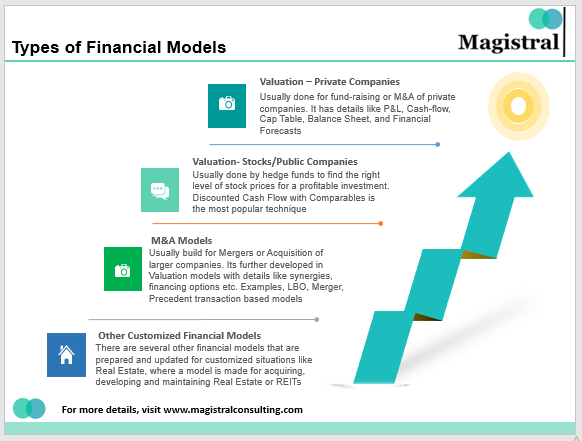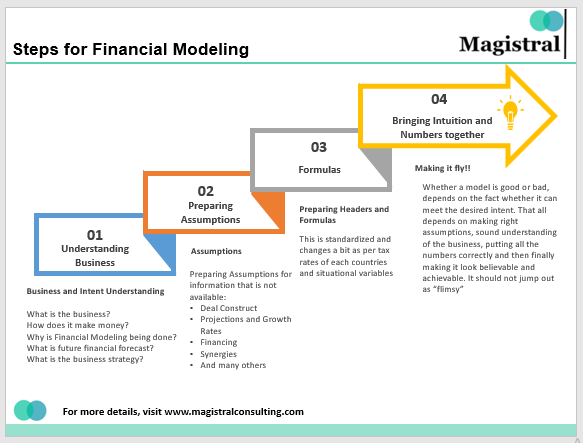Financial Modeling Outsourcing is fast catching up, this article focuses on the steps required to prepare a Financial Model that will attract the attention of investors. It also argues as to why it is all the more important to outsource financial modeling to bring in an expert’s point of view.
Financial Modeling Definition
Financial Modeling is an inseparable part of Investment Analysis. A financial model prepared on an excel sheet is used to analyze almost all investment decisions.
Financial Modeling is considered to be a quantitative exercise plainly dealing with numbers and formulas. Sometimes on excel and sometimes on software like R, VB, Python, etc. However, regular practitioners understand that this is more of an art than science. It doesn’t only need to be correct in terms of formulas and assumptions, it needs to sell as well to the client.
In the article we will also talk about Financial Modeling Outsourcing, that is fast catching up as a trend to ensure the quality of the Financial Model
Types of Financial Models

The investment community uses multiple types of Financial Models. Following are the broad types of Financial Model:
Financial Model for Private Companies: Private Equity, Venture Capital, and Investment Banking firms use this to find out the valuation of an asset. Financial Modeling and Valuations go hand-in-hand. Investment Banks also do it day in and day out for their clients. It’s for situations where a private company, a start-up, or otherwise is looking to raise funds from debt or equity or is looking for the opportunities of Mergers and Acquisition. This type of financial model has all the sections that are important for investing like P&L, Balance Sheet, Cash-flows, Working Capital, Cap Table, RoI calculations, exchange rates, Resource utilization metrics, and other relevant details.
The way assumptions are made for the future forecast of revenue is the heart of the financial model. All other numbers just follow these broad numbers. If assumptions on revenue and cost are wrong, a financial model can either give undervalued or lofty valuations, both of which have the potential to kill the deal, either from the buy or sell side.
Financial Model for Stocks: Investors in equity stocks, usually Hedge Funds or Investment Banks use these models for themselves or their clients. They arrive at buy, sell, or hold recommendations based on these financial models. A Discounted Cash Flow Model of the publicly listed stocks is at the heart of each recommendation. It has future financial projections built-in and is updated continuously based on the developments related to that company or industry. Formulas on the model are the same and still, different brokerages come to different recommendations for the same stock. Ever wondered why? It is all in the assumptions and assessment of development. A development or news can be seen as highly negative by a brokerage and hence a huge negative impact on future projections, whereas the same news could be assessed neutral by another broking house.
The key to a great financial model in this situation is to understand the culture of your client/investor. Are they conservative or high-risk takers? Depending on the culture, you can make appropriate assumptions and hence the recommendations that suit your clients. Comparables and peer analysis is also used along with the DCF modeling
M&A Models: Most M&A models build further on financial models for start-ups and companies. It carries specific sections around financing and payback, synergies, Leveraged Buyout details to assess if the proposed M&A is going to create value for everyone involved. The most commonly used models here are Merger Modeling and Precedent Transaction Analysis. Again assumptions are more important than the Formulas, as that can make or break the deal.
Other Models: A financial model is present usually before any sort of investment or fund-raising decision regarding any form of asset, whether we are talking about Real Estate, REITs, or a portfolio of crypto assets. Financial Model for Real Estate is in principle same as a Private Equity investment in a company but takes into account situations related to the concerning Real Estate.
Real Estate can be acquired and used differently, leading to different financial outcomes. A Real Estate financial model objectively analyses these scenarios and their financial outcomes. Say a land bank bought in the city center of a megacity could be kept vacant for capital appreciation. It could also be developed as an old-age hostel or a hotel. The second scenario will lead to rental income but at the same time will also require capital investments.
All this needs to be evaluated objectively to conclude if the proposed investment makes sense for the investors. Similar models are made to track the performance of REITs, or rent rolls coming from multiple commercial properties. There are multiple ways a Real Estate could give returns and all this leads to a hugely customized financial model specific to the situation. Real Estate Financial Modeling Outsourcing is catching up in a big way.
Steps to prepare a Financial Model- Financial Modeling Best Practices

The steps would change as per the financial model under preparation. Following are the generalized steps that are valid for usually all types of Financial Models:
Understanding the business and business situation: This is the very first step before putting in a single number in Excel, R, Python, VB, or any other software that you plan to use for Financial Modeling. More thorough is your understanding of the business, more reasonable are the assumptions and more chances of it flying with the client or investors.
Usually, a pitch deck is prepared before the financial model so that all stakeholders are clear about the business strategy. This is all the more important in the case of start-ups that are raising Series A with no previous revenue track record. An experienced practitioner asks lots of questions in this stage about the strategy, finance, human resources, market, geographies, products, patents, industry, people, and everything else related to the business.
A robust financial model demands an eye for details. If it is related to specific investing situations, questions should be asked around returns, risks, similar business models around, management team, etc. The financial modeling technique to be used in this specific business situation should also be finalized.
Preparing Assumptions: This is one of the most critical steps while preparing financial models. If Assumptions made does not make sense, it renders the whole financial model useless. Other than making reasonable and well-researched assumptions, the experienced practitioners also make sure assumptions could be changed in the model. Multiple stakeholders play around the model to finalize the contours of the deal. The standard aspect of deal-making is changing assumptions in the model. A well-made model is flexible in changing assumptions.
Preparing the model: Preparing financial models on Excel is most common however, models can also be created on R, VB, Macros, Python, etc. There are many off the shelf financial modeling tools that are available. Financial Model Templates are usually available at this stage. Standardization is the major part of the model in this stage. For example, any private company valuation model would comprise, P&L, Balance Sheet, Cash Flow, etc. These statements will have standardized headers and formulas too. The parts dependent on the nature of business are customized. A SaaS business for example will be very different from Steel business in terms of how they acquire customers and project revenue.
Bringing intuition and data together: This is the task of the most experienced operator in the field of financial modeling. It not only requires the knowledge of the formulas in the financial model but also a thorough understanding of business, its competition, and the industry as a whole. When that experienced operator looks at the valuation that the model throws, he instinctively knows if that is correct or not. The assumptions are played around with if the valuation is not in the expected ballpark. A valuation level that makes sense to both Buy-Side and Sell-Side is achieved by this exercise.
In the end, we see Financial Modeling is more of an art than the exact science.
The rationale behind outsourcing financial modeling
An expert at Financial Modeling has worked with multiple start-ups, Investment Banks, Private Equity, Venture Capital, and other Financial advisors multiple times before. They have templates available readily with them and know the right questions to ask. All this leads to a Financial Model that is in tune with what the investor ecosystem demands. If you are looking for Financial Modeling Outsourcing, Magistral Consulting (www.magistralconsulting.com) can help in multiple ways.
Magistral Consulting (www.magistralconsulting.com) is a leading player in the Financial Modeling Outsourcing space. It provides Financial Modeling Services. Magistral has specialization in preparing Financial Models for Private Equity, Financial Models for venture Capital, Financial Models for Real Estate, Financial Model for Investments Banks, Financial Models for Hedge Funds, Start-up Financial Modeling, apart from several other highly customized Financial Models. It has delivered Financial Modeling Projects globally to clients in the US, UK, Europe, and South-East Asia. For a business inquiry, you can drop a line at https://magistralconsulting.com/contact/
The Author, Prabhash Choudhary is the CEO of Magistral Consulting and can be reached at Prabhash.choudhary@magistralconsulting.com, in case of queries.